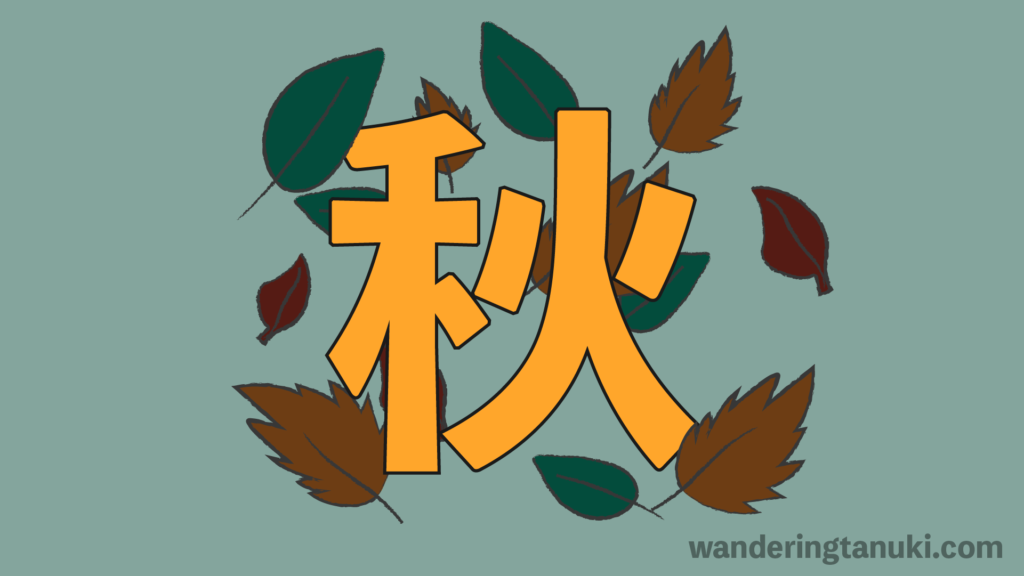Autumn in Japan: Seasonal foods, traditions, and sayings
Japan is beautiful in all of its seasons but Autumn in Japan can be a particularly colorful time of the year. There are all sorts of seasonal foods, traditions, and sayings that celebrate Autumn. In Japanese, Autumn is called 秋(aki).

Climate of Autumn in Japan:

In September, day time temperatures around Tokyo can still be warm at up to 28 degrees celsius (82 degrees fahrenheit). By November, daily high temperatures can be around 16.7 degrees celsius or (62.1 degrees fahrenheit).
The mild temperatures are great for enjoying outdoor activities and you won’t be too hot or too cold. Because of Japan’s geography, you can also experience a wide range of climates depending on where you go from the north to the south.
The best time to see the changing fall leaves is around late September to early November. The leaves will change at different times depending on the location. You’re bound to find a spot that still has beautiful leaves if you travel to the right place!
In September there can be typhoons so make sure to check the weather!
Seasonal foods:
Food plays a big part during the autumn season. Be sure to try some of these amazing autumn delicacies.

松竹 Matsutake – Matsutake Mushroom
This is one of the most prized mushrooms in Japan that can fetch a price of up to $1000 per kilogram. The reason they are highly sought after is because they cannot be cultivated. They can only be found in the wild under specific forest conditions. A popular dish with matsutake is matsutake gohan, where rice is made with sliced matsutake and light seasonings.
栗 Kuri – Chestnut
Another seasonal autumn food is chestnut. They are sweet and taste delicious as a snack or made into a paste for desserts. During the autumn, you’ll be able to buy roasted chestnuts and various Japanese sweets with chestnuts.
柿 Kaki – Persimmon
Persimmon are sweet fruits that appear during the late autumn. To get rid of bitterness some are turned into dried fruit called hoshigaki. In the past, this fruit was important for Japanese people when there was a limited amount of food.
秋刀魚 Sanma – Pacific saury fish
The name, sanma, includes the kanji for autumn (秋). The direct translation of the fish’s name is “autumn sword fish”. Fresh sanma during September is exceptionally fatty. You can eat it as sashimi, grilled, or pickled in vinegar.
サツマイモ Satsumaimo – Japanese sweet potato
Compared to other sweet potatoes, satsumaimo are much sweeter. Japanese people feel that it is a warm comforting food that reminds them of home. It’s most often eaten roasted but it can appear fried as a tempura, in desserts, and many other dishes.
れんこん Renkon – Lotus Root
A common ingredient in Japanese cuisine during the autumn season is lotus root. They have a similar texture to raw potato and can be found fried or braised. What’s unique about this root is the appearance. When cut there are several holes inside.
Traditions:
During the autumn in Japan there are many activities and traditions!

紅葉 Kouyou – Leaves changing color
Unlike in English, the Japanese language has one word that describes the changing of the autumn leaves.
紅葉狩りMomijigari – Going to see the leaves changing color
Going to see the autumn leaves is called momijigari. Momiji is the name of the Japanese maple tree. Because of its beautiful red color in the autumn, the activity of going to see the autumn leaves has been named by the Japanese maple.
お月見 Otsukimi – Moon viewing
This is a tradition celebrated on the 15th day of the 8th month of the lunar calendar. In modern times, this usually falls in September or October. During otsukimi, you can observe the full moon while enjoying dango (rice cakes). In the past, people would pray for the prosperous autumn harvest.
文化の日 Bunka no hi – Culture Day
Culture day is a national holiday on November 3rd. There are many events and award ceremonies in the arts and culture. In addition, Japanese school culture festivals are usually held close to this day.
七五三 Shichi go san – 7-5-3 year old day
Held on November 15th, this is a traditional celebration for 3 and 7 year old girls, and 5 year old boys. In the past, there was a higher child mortality rate in Japan. This is why it was important to celebrate these age milestones. Nowadays, it is more of a tradition and children are taken to the Shinto shrine wearing traditional clothes.
Sayings about Autumn:
There are all kinds of sayings for autumn in Japan!

食欲の秋 Shokuyoku no aki – Autumn of apetite
Japanese people believe that you have more appetite during the autumn. This could be because there are many flavorful foods as well as a milder climate for physical activity.
みのりの秋 Minori no aki – Autumn of prosperity
Many of Japan’s staple crops, like rice, are harvested during the autumn. For Japanese people, prosperity is associated with this time.
芸術の秋 Geijutsu no aki – Autumn of the arts
There is an increased interest in arts and culture during this season. This is because there is less stress in the autumn and more room to embrace the arts. The mild temperature helps people feel grounded and peaceful.
読書の秋 Dokusho no aki – Autumn of reading
Because there is less daylight, autumn is the perfect time for reading.
スポーツの秋 Supootsu no aki – Autumn of sports
In the past, school sports festivals were held in the autumn because it is the perfect temperature for sports.
別れの秋 Wakare no aki – Autumn farewell
This comes from the way that passionate summer flings tend to die out in the autumn.
I hope that this article has shown some of the best parts about autumn in Japan! There’s many more things about the autumn than included in this article so I encourage you to visit Japan and see it for yourself. If you want more Japanese culture and language blog articles be sure to check out Japanese School Events: Culture, Sports day, and more or 10 Unique Summer Traditions in Japan
~ Tanuki





